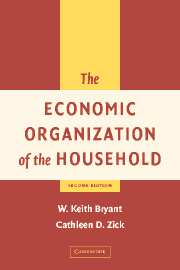Book contents
- Frontmatter
- Contents
- List of Figures
- Preface to the Second Edition
- 1 Introduction
- 2 Household Equilibrium
- 3 The Analysis of Consumer Demand
- 4 Consumption and Saving
- 5 Work and Leisure : How the Household Spends Its Time
- 6 Human Capital : Investing in Oneself and One's Family
- 7 The Economics of Fertility
- 8 The Economics of Marriage and Divorce
- References
- Index
8 - The Economics of Marriage and Divorce
Published online by Cambridge University Press: 06 July 2010
- Frontmatter
- Contents
- List of Figures
- Preface to the Second Edition
- 1 Introduction
- 2 Household Equilibrium
- 3 The Analysis of Consumer Demand
- 4 Consumption and Saving
- 5 Work and Leisure : How the Household Spends Its Time
- 6 Human Capital : Investing in Oneself and One's Family
- 7 The Economics of Fertility
- 8 The Economics of Marriage and Divorce
- References
- Index
Summary
INTRODUCTION
Similar to the changes in fertility and household time allocation, demographers have noted significant shifts in marriage and divorce patterns over the past fifty years. In 1950, the marriage rate per 1000 population was 11.1 and the divorce rate per 1000 population was 2.6. The median age at first marriage was 22.8 for males and 20.3 for females. Sixty-eight percent (66%) of all adult males (females) were married in 1950 and only 2.0 percent (2.4%) were divorced. By 2001, the marriage rate per 1000 population had declined to 8.4 and the divorce rate had risen to 4.0. The median age at first marriage had climbed to 26.9 for males and 25.1 for females. Only 60.8 percent (57%) of all adult males (females) were married in 2002 while 8.6 percent (11.2%) were divorced (U.S. Bureau of the Census 2000b; 2003). Clearly, over the past fifty years marriage rates have declined and both age at first marriage and divorce rates have risen significantly.
Can economic theory help us understand why people marry and divorce and why patterns of marriage and divorce have changed over time? Economic theory is relevant as a (partial) explanation of marriage and divorce only if marriage and divorce can be viewed as economic activities over which the individuals involved have choice. As with fertility, if individuals have no choice over whether they are married or divorced, then economics is irrelevant.
- Type
- Chapter
- Information
- The Economic Organization of the Household , pp. 262 - 306Publisher: Cambridge University PressPrint publication year: 2005

